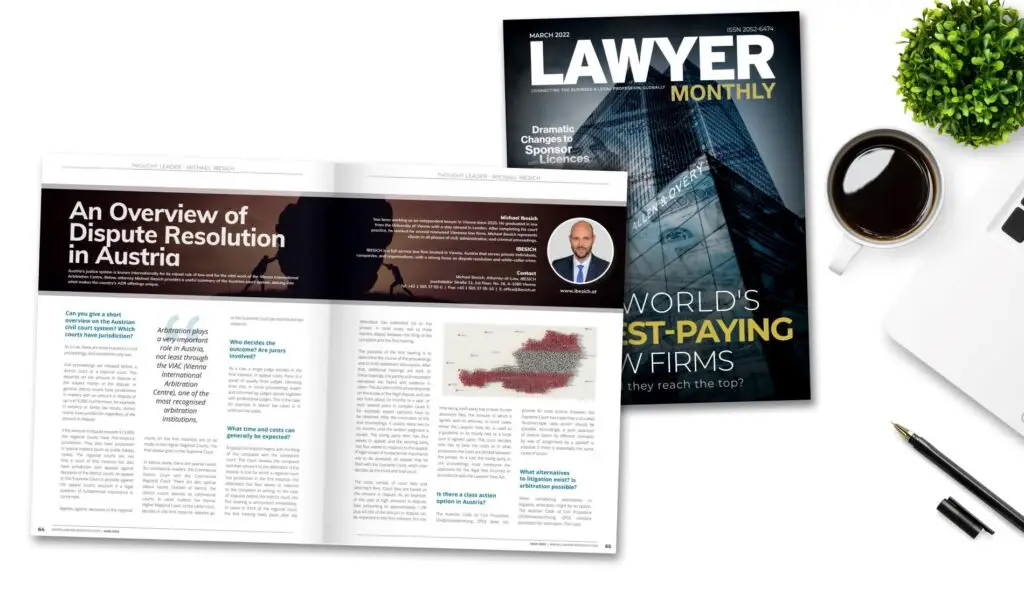
Division of assets in a divorce

Attorney specializing in family law & divorces, founder of the law firm IBESICH
Legal Notice/Disclaimer: The following information is intended for general guidance only and does not replace individual legal advice. For advice tailored to your specific situation, please consult a lawyer or another qualified legal professional.
A divorce is not only emotionally taxing but also has significant financial consequences. One of the most important aspects is the division of assets, i.e., the fair distribution of the spouses’ joint assets.
In Austria, the marriage is generally governed by separation of property – each spouse remains the owner of the assets they brought into the marriage or acquired during it.
However, in the event of a divorce, the marital utilitarian assets and the marital savings are divided between the spouses according to statutory rules. The goal is a fair solution that enables both ex-partners to start anew on a secure financial footing.
This guide clearly explains what needs to be considered in asset division under Austrian law and how you can avoid disputes.
What you need to know
Divisible estate:
Everything acquired or saved during the marriage for joint living expenses.
Exceptions:
- Premarital property
- Gratuitous transfers (inheritances / gifts)
- Purely personal items
- Professional and business assets (unless held purely as investments)
Options:
- Amicable agreement
- Judicial division
Key dates:
- Start date = date of marriage
- End date = termination of marital cohabitation (separation)
- Application no later than 1 year after divorce (for judicial division)
Typical points of dispute:
- Marital home / real estate
- Savings & investment accounts
- Vehicles
- Insurance policies
Table of Contents
Legal Basis
The legal basis for the division of assets in Austria is primarily the Marriage Act. It regulates the distribution of marital utilitarian assets and savings, the exceptions, and the criteria for division.
Important is the principle of equity: after divorce, assets should be distributed as fairly as possible between the ex-partners. Fault for the breakdown of the marriage is not taken into account. Instead, special attention is paid to each spouse’s contribution to the acquisition of joint household goods and the accumulation of savings, as well as the needs of any common children.
Special provisions also stipulate that after the marriage, the living areas of the ex-partners should be kept as separate as possible (the so-called separation principle), and that transfers of real estate ownership should only occur if no other solution would be fair (the so-called preservation principle).
What Is Included in Marital Assets?
Definition of Marital and Premarital Assets
As marital assets for the purposes of division, all those assets count that the spouses acquired during the subsistence of the marital community and that were intended for joint living expenses. This includes jointly purchased everyday items (household goods, vehicles, etc.) as well as jointly accumulated savings and investments.
It is irrelevant who provided the funds or in whose name an asset is registered—as soon as the item was intended for both spouses, it is part of the marital utilitarian assets or marital savings.
Premarital assets, by contrast, include all assets that one spouse already owned before the marriage. Such assets acquired before the marriage generally remain with the spouse who brought them in and are not subject to division upon divorce.
Example: If the wife purchased a condominium before the wedding and it remained solely in her name and was not used jointly during the marriage, it does not fall into the divisible estate. However, care must be taken: if the premarital asset was used jointly during the marriage or joint investments were made into it, at least the increase in value may become relevant.
In summary, all assets that the partners earned, purchased, or saved together between marriage and separation count as marital assets to be divided. Excluded are those assets that clearly remained a partner’s personal property and were never part of the joint economic activity.
Gifts and Inheritances
Money or items that a spouse receives as a gift or inheritance during the marriage constitute a special category and are excluded from division.
This means, for example, if the husband receives a large sum of money as a gift from his parents during the marriage or the wife inherits real estate from an aunt, that asset remains with the recipient in the event of divorce. The other spouse has no direct claim to it.
Important: This exception applies only unless the spouses have agreed otherwise. In theory, partners could stipulate in a prenuptial agreement that inheritances or gifts are to be shared—but this is uncommon. In practice, an inheritance or gift is usually kept in a separate account or clearly documented to prove in the event of divorce that these funds did not originate from joint earnings.
If, for instance, an inheritance was immediately used for joint purchases (e.g., using the inherited money to renovate the family home), it can become more complicated: then the value may indirectly enter the division calculation because it has been “absorbed” into a marital asset. As a general rule, however, what one ex-partner has received gratuitously from a third party does not have to be given to the other.
Also excluded by law are items that a spouse acquires for personal use and their professional equipment. This includes, for example, clothing, jewelry, personal collections or hobby equipment used by only one person, as well as tools, computers or professional literature needed for one’s job. Such items remain with their owner and are not divided, even if acquired during the marriage.
Business Interests
If one spouse owns a business or business interests, the question often arises whether these are part of the division. Items belonging to a business and shares in a company are excluded from division—unless they are merely held as investments.
This means, for example, if the husband runs his own business, that business is not split apart. Likewise, company shares (e.g., GmbH shares) held by a spouse generally remain unaffected if the spouse is actively involved in the business.
It can be different if the company shares were held purely as an investment (e.g., securities, stock portfolios), or if marital funds were invested into the business. If the interest is purely for asset investment, it counts as marital savings and would be subject to division. In practice, this is scrutinized: if the spouse actively worked in the company, the protection of § 82 applies; if it was only a silent investment, the value may need to be divided.
Importantly: even if the business itself is not divided, the other spouse may still claim compensation if marital funds substantially contributed to the business’s value. The court can then decide, for example, that the spouse active in the business must pay a settlement to the other rather than transfer a share of the business. This prevents a company from being dismantled by divorce while still recognizing the other’s contribution.
Debts
A complete asset inventory also includes the spouses’ debts. It is not uncommon to have joint loans (e.g., for a house or car) or debts incurred in the interest of the family. As a rule: debts closely related to marital living expenses or to acquired assets are considered in the division. Net values of assets (market value minus outstanding loan) are calculated.
For example: if a joint car was purchased on credit, upon divorce the current value of the car and the remaining loan balance are assessed. Only the equity is divided; the remaining loan is allocated proportionally or deducted from the vehicle’s value. The same applies to mortgaged real estate.
Debts that are not related to the joint household or assets—such as a personal loan for a hobby or old debts from before the marriage—remain with the spouse who incurred them.
Such personal debts are not divided. This means no one must pay the other’s private liabilities after divorce (unless they jointly signed as co-debtors).
Important to note: creditors remain bound by the original loan agreements. Internal debt division between ex-spouses does not change who is liable to the bank. Therefore, divorced partners often must agree separately (or have it decided by court) who will pay future installments or whether a loan will be restructured. Divorce asset division can stipulate that one ex-spouse assumes a debt alone and holds the other harmless. Nevertheless, the bank retains the right to pursue both parties as long as both signed.

Timing of Asset Division
Separation vs. Divorce Date
The decisive factor for which assets are divided is the date of termination of the marital community – in simple terms: the date of separation. In many marriages, separation and legal divorce occur at different times. The law refers to which marital utilitarian assets and savings existed at the time the marital community was dissolved.
Practically, this means: any new assets acquired after separation from “table and bed” are no longer part of the divisible estate. Conversely, everything accumulated up to separation is considered, even if the divorce only becomes legally binding months or years later.
The termination of the marital community is the moment when at least one spouse has definitively ended the shared household and life arrangements (e.g., one spouse moving out of the marital home or other clear separation). This separation date serves as the cut-off date for asset division. From that point on, further asset increases are generally not regarded as “joint.”
For example: the spouses separate in January, live apart from then on, and in July of the same year the divorce becomes final. Everything that existed or was acquired jointly by January is divided. If one spouse buys a new car or saves additional money from their own income after separation, it no longer falls into the joint pool.
Note that neither party may unlawfully diminish the marital assets between separation and divorce. Anyone who causes joint savings to “disappear” or consumes assets after separation must expect the court to treat them as if they still existed. Section 91 of the Marriage Act states that concealed or dissipated assets can be included if a spouse intentionally reduced the joint assets—particularly through unusual investments inconsistent with marital living standards and made within two years before separation. This provision prevents someone from spending large sums without their partner’s consent just before divorce to reduce the divisible estate.
Statutory Cut-Off Dates
In summary, there are two key dates for asset equalization:
- Start date: the date of marriage. Asset increases are only relevant from marriage onward; everything before remains excluded (as brought-in assets).
- Cut-off date: the date of termination of the marital community (separation). Assets acquired up to that point are divisible; those acquired afterward are not.
For valuing some assets, a third date may come into play: the value at the time of the court decision. When deciding on division, the court typically uses the current value of assets (i.e., at the time of judgment or first-instance ruling). Value increases between separation and decision are considered if they arose without either spouse’s intervention (e.g., general real estate appreciation). However, if one spouse enhanced an asset’s value after separation through their own efforts (e.g., renovating a house single-handedly), that increase may be taken into account so this benefit does not unfairly accrue to the other.
In summary: the period from marriage to separation defines what counts as joint acquisition. Asset division then applies to that period, with actual valuation usually set at the time of divorce or court decision. Separation acts, such as moving out, mark the boundary beyond which no further “joint” assets are created.

Options for Asset Division
Amicable Agreement
The best way to settle asset division is through an amicable agreement between the spouses. In the context of an uncontested divorce, the spouses must submit a comprehensive divorce agreement that already specifies, among other things, the division of assets and debts. This so-called divorce settlement agreement ideally contains a clear arrangement as to who receives which assets and who assumes which debts. The spouses have flexibility here: they can choose a division that suits both of them, even if it deviates from the statutory 50/50 rule.
An amicable settlement offers several advantages: it spares nerves, saves time and costs, and usually leads to a result both can live with better than a court decision. The partners know their financial situation best and can find creative solutions (e.g., asset swaps or installment payments for a balancing payment).
Such an agreement must be concluded legally validly. In Austria, agreements on the division of marital savings or the marital home must be executed by notarial deed. For other utilitarian assets, written form is generally sufficient, but it is also advisable to notarize important agreements to secure their validity.
The notarial deed requirement applies particularly to real estate: if, for example, it is agreed that the husband receives the marital home and the wife receives a settlement payment, this agreement must be notarized so that land register changes can be made. A notarial deed is also necessary when dividing larger savings balances. Smaller items (furniture, car, etc.) can in principle be divided informally, but a clear written agreement is recommended here as well to avoid misunderstandings.
Note that an amicable agreement is also possible during court proceedings. In this case, no notarial deed is required.
The amicable agreement can be drawn up with the help of lawyers or mediators. It is important to fully disclose and fairly value all assets and debts. Once an agreement is reached, it is recorded in writing. In the course of the uncontested divorce, this agreement is then approved by the court, giving it additional binding force. After that, any transfers (e.g., transfer of real estate) can be carried out.
Judicial Decision
If no agreement can be reached, the judicial asset division remains. This takes place by application after the divorce is final – known as the partition proceedings. Here, the judge decides how the assets are to be distributed according to statutory provisions. Both ex-partners must disclose all their marital assets; a detailed inventory of all assets and debts is often required.
The court then examines what falls into the divisible estate and what does not, and assesses the value of each item. Finally, taking into account contributions and circumstances (see division factors), a division key is established, usually in percentages or specific allocations.
In practice, a court decision often results in quotas or balancing payments: for example, the judgment may decree that each spouse receives half of the joint savings, the car remains with the husband (who pays the wife €X as compensation), and the marital home is awarded to the wife (who pays the husband €Y). The court has relatively broad discretion to find a “fair” solution, but it is bound by the guidelines of the Marriage Act (e.g., consideration of children, contributions, etc.).
Judicial partition proceedings can be quite lengthy and costly, depending on the complexity of the assets and the intensity of the dispute. Both parties initially bear their own attorney’s fees; in the end, the prevailing party may receive a cost reimbursement if one party clearly loses.
Expert appraisers are often called in for such proceedings (e.g., for real estate valuations). The process is less formal than a civil trial, but evidence must still be presented (e.g., regarding contributions or the origin of assets). The burden of proof for whether something is included or excluded often lies with the party claiming the exception. For example, the husband would have to prove that amount X in his account was a gift from his parents if he wants to exclude it.
Note: In many cases, an out-of-court agreement is not possible at first, so a court decision is initially sought. Nevertheless, an amicable agreement can be reached at any time – in practice, this is often the case. This can particularly avoid the often high costs of expert reports. Such court settlements do not require notarial authentication.
Attention: An application for judicial partition must be filed within one year after the divorce. If this deadline is missed or one explicitly waives partition, each retains what they have at that time. Therefore, if an agreement is not possible, one should promptly pursue the judicial route to secure claims.
Mediation as an Alternative
Between private agreement and formal court proceedings lies the possibility of mediation. Mediation is a voluntary process in which a neutral mediator (often a specially trained lawyer or psychologist) helps the couple find an amicable solution to disputes such as asset division. Mediation sessions take place in a protected setting, and the mediator assists both parties in disclosing their interests and negotiating constructively.
The great advantage of mediation is that solutions can be developed that are tailored to the individual situation and that both parties can live with. Especially in financial matters, creative compromises can be found (e.g., one spouse receives more cash assets, the other receives all household goods, etc.). Mediation can also help ease hardened positions and enable communication, which is particularly important if the ex-partners must remain in contact, for example, because of shared children.
Mediation is not mandatory in Austria but is often recommended by courts and counseling centers. In divorce proceedings, the judge often points out the possibility of mediation at the outset. Therefore, if it is foreseeable that the asset issue will be contentious, it may be sensible to engage a mediator early. The costs of mediation are usually borne by the parties themselves, often split fifty-fifty. These costs are in many cases significantly lower than a lengthy legal dispute.
If an agreement is reached in mediation, it is recorded in writing. Subsequently, with legal support, it can be turned into a binding divorce agreement (e.g., notarized). Mediation can thus pave the way for an amicable divorce, even if the spouses initially seemed far apart. If no agreement is reached, one can still go to court; statements made during mediation are confidential and may not be used against a party in court. There is therefore no risk that openness in mediation will be “regretted” later in court.
Important Factors in Division
The statutory requirement of “division according to equity” means that the court must consider the individual circumstances of the marriage in case of dispute. The following factors play an important role:
Duration of the Marriage
How long the marriage lasted often influences the division. Generally: the longer the marriage, the more comprehensive economic interdependence is assumed and the more likely an equal division. In very short marriages (e.g., only 1–2 years with no children), courts tend to handle the division sparingly – each spouse usually retains what they contributed, as little joint accumulation took place. Conversely, in marriages lasting decades, all assets acquired during that time are viewed as a shared life’s work, regardless of formal ownership. Accordingly, a 50:50 split is typical, unless there are special reasons to deviate.
Marriages of moderate length are also judged fairly by duration. For example, a 10-year marriage may result in a different division than a 30-year marriage, because after 30 years both partners’ lives (including finances) are assumed fully intertwined. Duration is not an isolated arithmetic factor but provides context: a longer marriage offers more opportunity for both to contribute to joint prosperity, which equity seeks to balance.
Contribution to Household Management and Childcare
One of the key division factors is the contribution of each spouse to asset acquisition. This contribution can be financial, in labour, or in household and childcare services. The law clarifies that, for example, running the household, raising children, and other marital support are to be valued equally with earning income. This so-called household and family work is explicitly equated.
In practice: if one partner primarily managed the household and cared for children during the marriage while the other worked, it is assumed that the value of that household work enabled the other’s income-earning. Without that work, the working spouse could not have pursued their career so freely. Consequently, the non-working spouse has full entitlement to half of the jointly created assets, even without personal income.
Especially in traditional marriage models (e.g., husband works, wife cares for home and children), this rule prevents the homemaker from being left financially disadvantaged. Her contribution is recognized as equivalent. In court the question is not “Who earned how much?” but “Who contributed what?” Invisible work in the kitchen, nursery, and caregiving is expressly valued.
Economic Circumstances of the Spouses
The overall financial situations of the spouses can also influence division. This includes questions such as: does one partner have substantial separate assets outside the marriage (e.g., a large inheritance not subject to division)? What is each person’s income and asset situation after divorce? The law aims to prevent one ex-spouse from being placed in an unreasonably poor position while the other continues as before. Therefore, a court may decide in favour of the weaker spouse when there is a stark imbalance.
For example: if the wife never worked during the marriage and has no personal assets, while the husband earned a multiple of her salary and holds large non-divisible assets, the court might allocate a larger share of marital assets to the economically weaker spouse. According to the Supreme Court, the goal is to avoid an extreme deterioration of one partner’s living conditions. Of course, the court cannot allocate beyond the marital estate, but within the estate division it can, for example, adjust from 50:50 to 60:40 when equity reasons exist.
Another aspect is future earning capacity: if one spouse is unlikely to earn much due to illness or age, while the other is in peak earning years, this may be considered indirectly by leaving a greater share to the weaker spouse. However, this issue is often addressed through post-marital maintenance (alimony) rather than unequal asset division, as the law fundamentally presumes equal division with limited exceptions.
Investments Made During the Marriage
Special investments and contributions that a spouse made to joint assets during the marriage are also highly significant. For example: one spouse brings a partly built house into the marriage, and the other invests considerable time and money to complete and substantially enhance it. Or one partner injects significant funds into the other’s business. Contributions beyond normal daily routine are taken into account.
Although the law does not explicitly state “whoever invested more gets more back,” equity principles incorporate these circumstances. In particular, value increases of contributed assets due to a spouse’s efforts are customarily shared. The Supreme Court has ruled that the appreciation of a property brought into marriage is to be split equally when both contributed equally to its enhancement. Even if the property itself is non-divisible (brought in), the other spouse can claim a share of the gain.
Specifically: if, for instance, the wife contributes a plot with a shell structure into the marriage and the husband finances and completes the house, the plot remains her property, but the increase in value from the construction is divided. That value share can be compensated through a balancing payment.
Similarly, if one partner uses joint savings to increase the other’s assets (e.g., paying down a loan in the other spouse’s name), this counts as a contribution to asset building that should be balanced upon divorce. Generally: all financial or labour inputs into the common project of marriage are considered – no one should feel the other profited unfairly from their efforts.

Typical Points of Dispute – Who Gets What?
Real Estate (Joint House/Apartment)
Real estate is probably the most common point of dispute in asset divisions. The question “Who gets the house?” is explosive – after all, it involves high values and often the family home. Here are some typical scenarios and solutions:
If the property belongs to both spouses as 1/2 shares (e.g., jointly registered in the land register), it is usually either sold and the proceeds divided, or one spouse keeps the property and buys the other out. The buy-out amount is based on the current value of the property minus any debts and divided according to the agreed share (often 50:50). Frequently, the ex-partner who will live there with the children wants to keep the house. They must then compensate the other financially, either by a one-time balancing payment or by taking on a larger portion of the joint debts.
If the property is encumbered with a mortgage, this is taken into account in the calculation. Example: The house has a market value of €300,000, the outstanding loan is €100,000. The net asset value is therefore €200,000. With a half-and-half split, each would be entitled to €100,000. If the wife takes over the house, she would therefore have to pay the husband approx. €100,000 as compensation (either by assuming the loan or in cash). If the departing spouse continued to pay the mortgage alone after separation, those payments increase their claim accordingly. Conversely, sole mortgage payments by the spouse remaining in the house after separation do not reduce their buy-out obligation – they increase their equity in the property. In practice, such calculations scrutinize exactly who has borne which burden since when.
Complicated are cases where the house belongs to one spouse alone (e.g., brought into the marriage or inherited). Then it is generally excluded from division. However, if both lived in it, the other often has at least a strong interest in a right of residence or compensation. Courts can, in special cases, grant the non-owning partner a time-limited right of residence in the marital home, for example until they find a new place to live. Especially when children are involved, it is often decided that the primary caregiver may remain in the marital home with the children – regardless of ownership. The owner then receives, for example, a larger share of other assets or a monetary compensation instead of the home.
With joint loans on a property, both remain liable to the bank (if both signed), regardless of internal arrangements. Therefore, in a divorce settlement agreement or court order, it is usually stipulated that the spouse who takes over the house also assumes sole responsibility for the loan and releases the other from liability (subject to the bank’s approval). If this fails, other compensatory arrangements must be made. It is always advisable to involve the bank early if, for example, refinancing or assumption is planned.
A special case is the so-called marital dwelling rented. If a couple lived in a rental property they both signed for, the question arises who continues the lease. Under Austrian tenancy law, it can be agreed or court-ordered in divorce that one spouse takes over the lease alone. The other is then released from the contract. Often the welfare of the children or the neediness of one spouse determines this. The landlord must accept the lease takeover if the court orders it. The spouse who moves out then has no further claim to the apartment, but also no obligations (rent payments).
Overall, real estate requires careful consideration and often expert appraisals (for valuation). Finding a fair solution is important because the home strongly influences quality of life after divorce. Therefore, this point usually receives much attention in negotiations.
Savings Accounts, Securities, Life Insurance
Financial assets such as bank balances, securities portfolios and insurance policies are also frequently contested. Typically, these include savings books, investment funds, stock portfolios or capital-forming life insurance policies accumulated during the marriage. Such marital savings must be divided. Usually, account balances are determined at the cut-off date and split in half, unless there are reasons for a different share.
It is important that really all accounts and investments are disclosed. Sometimes one partner tries to withdraw money quickly from the joint account or hide savings. The court can see through such actions and – as mentioned above – treat the money as if it were still there (up to the amount improperly withdrawn). Transparency is therefore essential, as deliberate concealment of assets can have negative consequences in proceedings.
Securities and funds: These are divided based on their current portfolio value. For stocks, one often has to account for price fluctuations – often the solution is either to split the portfolio (sell each holding half and divide the proceeds, or physically allocate shares) or to award the entire portfolio to one partner and compensate the other in cash. The latter can be sensible if one partner is more knowledgeable or particularly attached to certain holdings.
Life insurance: Capital-forming life or pension insurance policies (with surrender value) also count as marital savings. Their surrender value at the cut-off date is included in the calculation. One can transfer the policy to one spouse and compensate the other, or surrender it and split the proceeds (though early termination usually incurs losses). Pure term life insurance without a savings component has no relevant asset value.
When children are involved, there are sometimes savings books in the children’s names. This is a sensitive area: although these funds formally belong to the child, the deposits often come from the parents. If these savings books were mainly used to build parental assets (as a “parking account” for their own money), courts may still treat them as part of the marital assets. However, this is an exception – the children’s assets generally remain excluded. Only if one parent claims the other transferred money to the children to shield it from division could this become relevant.
Private pension provisions: Private pension products (e.g., private annuities, pension funds) accumulated during the marriage are considered investments and thus marital savings. However, determining and dividing their value can be complicated, especially if they are not surrenderable before maturity. There have been Supreme Court rulings on when such entitlements must be divided. Generally, the entitlement earned up to separation is valued – whether an equalizing payment or other assets are then allocated depends on the case. If a private pension policy is divided in divorce, one can agree that each spouse receives their own policy with half the value, or that one spouse pays the other half the surrender value. Legally, this falls under the general division rules.
Household Goods and Vehicles
Household goods: Furniture, appliances, dishes, electrical devices and all everyday household items are treated as part of the marital utilitarian assets. In many cases, ex-partners can agree relatively easily on who takes what. Household goods are often divided by usage and need: which items did who mainly use? Who will need what in the future? Often most household items remain with the partner staying in the marital home (with children), as they continue the household. The other partner may then receive individual items or financial compensation if items are particularly valuable.
For everyday items, valuation is often difficult because used goods have low market value. It usually isn’t worth disputing every sofa or toaster. Courts therefore welcome out-of-court agreements. If it goes to court, a lot drawing is often used: each lists the items they must have, and the rest is allocated by drawing lots or at the court’s equitable discretion. In practice, household goods can almost always be divided privately.
Vehicles: The family car (or cars) is also often an issue. If there is one car primarily used by one spouse (e.g., the husband’s company car), it often remains with them, possibly against compensation to the other. If there were two cars, each keeps theirs – with adjustments if values differ significantly. If only one car exists and both need mobility, it gets tricky. Solutions include one spouse keeping the car and compensating the other with other assets or cash so they can buy their own vehicle.
Some household items are emotionally contested – such as pets or keepsakes. Pets are legally considered property, but practically an amicable solution is sought for the animal’s welfare (e.g., who keeps it and whether the other has visitation rights). Keepsakes like family photos are simply copied today so both can have them. Overall, household goods, etc., are often discussed, but compared to real estate or investments, they involve lower material value, so agreements are easier to reach.“`

Precaution and Security
Marriage Contracts / Divorce Agreements
To prevent uncertainties in the event of a possible divorce, couples can conclude a marriage contract (marital pact) in advance. In Austria, it can be agreed therein, for example, that certain assets in the event of divorce are divided differently than provided by law. Popular is the agreement of separation of property with exclusion of division – in other words, the contract stipulates that assets acquired during the marriage will not be divided upon divorce, or it sets fixed shares. However, such a contract must meet strict formal requirements: it is only valid if concluded as a notarial deed, i.e., with the involvement of a notary and the simultaneous presence of both partners.
Marriage contracts can be concluded before marriage (prenuptial) or at any time during the marriage. They are particularly useful when unequal asset situations exist or special assets are to be protected (e.g., family businesses, multi-generational real estate). With a marriage contract, one can stipulate, for example, that a certain business is to be exempt from the division law, or that a specific amount is paid as compensation in the event of divorce and no further claims exist.
In addition to classic marriage contracts, there is also the option of a divorce settlement agreement at the time of separation. If divorce is foreseeable, the (still) spouses can make an agreement that regulates all divorce consequences – maintenance, custody, visitation times, and also asset division. Such an agreement is usually concluded in the course of an uncontested divorce. Formal requirements also apply here: in particular, the division of assets (savings, real estate) must be notarized or recorded by a court to become legally effective.
It is important that marriage contracts and divorce agreements must withstand a review for immorality. A completely one-sided disadvantage of one partner could be invalid. For example, a marriage contract in which one spouse waives all claims and would receive nothing in the event of divorce would likely not hold up if it is grossly unfair. Courts examine in disputes over marriage contracts whether both parties understood the consequences and whether one was unduly advantaged.
Nevertheless: a balanced marriage contract can create clarity and prevent disputes. It should ideally be drafted with legal advice. Experience shows that marriage contracts are often concluded in good times and then save a lot of trouble in bad times because both knew what they were agreeing to.
What Can Be Arranged in Advance?
In addition to formal marriage contracts, there are also more informal ways to secure oneself. For example, partners can maintain separate accounts in everyday life and clearly document larger purchases (who contributed how much?) to have a basis for argument in the event of separation. While equalization of accrued gains cannot be completely avoided, clear financial separation can make many things more transparent.
Precautions can be taken for certain assets: for instance, if one has inherited a family home and wants to protect it from division, one could consider transferring it to the next generation in advance (though this raises inheritance share issues and must be considered carefully). Or one takes out insurance that provides benefits in the event of divorce – although there is no such thing as “divorce insurance” per se.
Another option is the execution of a notarial deed for gifts within the marriage. For example, one spouse transfers half the house to the other during the marriage (as a gift). A refund clause for the event of divorce can be agreed in the gift contract – but this is complex and requires notarial advice. This is difficult territory because gift and division law intersect.
More practical is often to draw up an out-of-court agreement early in the event of separation, even if divorce has not yet been finalized. If both realize that the marriage is ending, they can already carry out a division before the official divorce (e.g., separate accounts, clarify who keeps which car, etc.). This can later serve as a basis for the divorce agreement. However, one should be cautious: everything done in terms of asset transfers should be documented in writing and be fair, otherwise disputes may arise later or one may feel pressured.
In general, the clearer and earlier important points are regulated, the lower the potential for conflict. Preventive arrangements should always be carefully designed – preferably with the help of a notary or lawyer – so that they hold up in the event and do not themselves become a subject of dispute.
Tax and Financial Implications
Real Estate Transfer Tax and Property Transfer
When transferring real estate as part of a divorce, the question of the real estate transfer tax immediately arises. Normally, any change of ownership of a property triggers this tax (typically 3.5% of the value). Within a family context—including transfers between divorced spouses in connection with divorce—there are, however, exemptions.
Since 2016, a graduated rate applies to gratuitous transfers among close relatives: 0.5% for the first €250,000, 2% for the next €150,000, and 3.5% only beyond that. If, for example, in a divorce settlement the husband transfers his half-share of the house to the wife, this transfer is treated as “gratuitous within the family” and the reduced graduated rate applies, which is usually much lower than 3.5% of the full value.
Important: Even if one spouse makes an equalization payment (buy-out) to the other in order to assume the property, the transfer remains privileged for tax purposes. It is treated as if it were gratuitous, meaning you pay the family rate rather than 3.5% on the full purchase price, even if cash changes hands. This regulation is meant to relieve divorcing couples and prevent tax burdens from hampering the division.
In addition to the transfer tax, a land register fee applies to property transfers (currently 1.1% of the value). This fee must be paid by the new owner. While there are certain concessions for agricultural and forestry transfers within a family context, urban property transfers generally incur the full 1.1%.
You should also consider the real estate capital gains tax (ImmoESt): if a property is sold (e.g., to a third party because neither spouse wants it), ImmoESt may apply to the capital gain. This often affects the former family home if it was not exclusively the primary residence of both spouses. However, if the property is transferred between divorcing spouses, no ImmoESt is due, as there is no sale to a third party.
In summary, transfers between ex-spouses in the course of asset division are tax-privileged—especially due to the reduced transfer tax rate. Still, one should observe the formal requirements (notarial deed, register fee, etc.) and ideally seek tax advice when transferring substantial assets.
Effects on Maintenance and Pension Entitlements
Asset division, maintenance, and pensions are three separate areas, but they intersect:
Maintenance: The division of assets can indirectly affect post-divorce maintenance. In Austria, spousal maintenance is primarily based on fault and living standards during the marriage. If an entitled ex-spouse is sufficiently secured by the asset division (e.g., retains a home or savings), this can reduce their need and thus the maintenance amount. Often, asset division and maintenance are negotiated together in divorce settlements: for example, the wife may waive long-term maintenance in exchange for a larger share of the assets (a kind of buy-out). Such packages must, however, be fair and convince the court that neither party is unduly disadvantaged.
For child support, asset division plays no direct role—child support is calculated based on the payer’s income. Of course, a substantial loss or gain of assets can affect future income (e.g., saving on housing costs if one keeps the family home), but legally, child support remains separate.
Pension entitlements: Unlike Germany, Austria does not have an automatic pension-splitting mechanism upon divorce. Each spouse retains their own statutory pension entitlements. However, there is an optional pension-splitting instrument for parents: one spouse may transfer part of their pension credits to the other if they have raised children together. This must be requested during the marriage, no later than the child’s seventh birthday. If not exercised by divorce, the option is lost.
Company and private pension schemes, to the extent they have a capital value, are accounted for in asset division (see life insurance above). Thus, one spouse might receive half of a private pension policy’s value, increasing their own retirement income, while the other correspondingly receives less. In this way, asset division can influence future pensions.
A key point is the widow’s or widower’s pension for divorced spouses. In Austria, divorced partners are entitled to a survivor’s pension if the deceased was legally obligated to pay maintenance at the time of death (by judgment, settlement, or contract). Even without a formal title, if the deceased voluntarily paid maintenance regularly for at least one year and the marriage lasted at least ten years, an entitlement exists. Thus, if the ex-spouse dies and the divorced partner received maintenance, they can claim up to 60% of the deceased’s pension, depending on their own income. However, if the divorce settlement included a maintenance waiver (in exchange for a larger asset share), no survivor’s pension may arise because no maintenance obligation existed. This should be considered when negotiating settlements.
In summary: asset division and maintenance often indirectly influence each other. A balanced overall settlement in divorce cases should consider both. Pension law does not provide ex officio splitting, but divorced, maintenance-entitled persons are protected by the possibility of a survivor’s pension if the obligations were in place. Ultimately, both the immediate post-divorce financial situation (assets + any maintenance) and long-term security (pension) should be taken into account and distributed fairly.
Asset Division in International Marriages
Which Law Applies?
For binational couples or those who have lived abroad, the question arises: which law governs the division of assets? This is where private international law comes into play. Since 2019, the EU Matrimonial Property Regulation provides a unified regime for matrimonial property that Austria participates in. Couples may choose the applicable law by agreement (e.g., Austrian law if one spouse is Austrian). If no choice is made, the law of the state where the spouses had their first habitual residence after marriage applies, or otherwise the law of their common nationality. If that is also unclear, further connecting factors may apply.
Example: An Austrian citizen marries a German, and they first live in Germany, then move to Austria. Without a choice of law, German property law could apply (first habitual residence in Germany), meaning the German matrimonial property regime would govern, even if the divorce is in Austria. Conversely, two Germans living in Austria might be subject to Austrian law if they did not have a common first residence in Germany. In practice, couples often agree on one legal system to ensure clarity.
Important: A prenuptial agreement can explicitly designate which law governs the matrimonial property regime. This is highly recommended in international situations to avoid complex disputes later.
The jurisdiction question is separate: which court has competence? The EU has its own rules for divorce jurisdiction. A divorce (and thus asset division) can theoretically be filed in more than one country – e.g., either spouse’s home country or the country of residence. Legal advice can help determine where divorce is most advantageous or which law is preferable.
Recognition of Foreign Judgments
If a foreign court has already decided on asset division, recognition in Austria must be considered. Within the EU (for states bound by the Matrimonial Property Regulation), judgments on matrimonial property are generally mutually recognized. Thus, a German court’s decision on property division is enforceable in Austria without a new proceeding; only formal recognition is required, which is usually straightforward.
Outside the EU or for states not party to these rules, it can be more complex. However, Austria generally recognizes foreign divorce judgments (provided the procedure was fair and jurisdiction proper). Property aspects are either covered by that judgment (and recognized) or must be applied for separately in Austria.
A key point: real estate is governed by the law of its location. A property in Austria may not be effectively dealt with by a foreign divorce judgment alone. Austrian courts emphasize that foreign properties can in principle be included in the division. Conversely, an Austrian property can pose challenges if a U.S. court grants the divorce—separate proceedings in Austria may be needed to transfer title, as a U.S. judgment alone may not suffice for land register changes.
International cases are highly complex. It is always advisable to seek legal advice familiar with both Austrian law and the other relevant legal system to plan ahead and ensure a smooth division of assets.
Practical Examples and Court Decisions
To illustrate, here are some typical real-world examples and key principles from court rulings:
- Example 1 – Inherited House with Appreciation: Mrs A brings a house (valued at €150,000 at the time of marriage) into the marriage. During the 20-year marriage, both spouses jointly pay off the remaining mortgage and invest in renovations, so that at divorce the property is worth €300,000. Under § 82 of the Marriage Act, the house itself remains her premarital asset. However, its value doubled through joint efforts. Outcome in an actual case: the €150,000 appreciation is split equally. Mrs A keeps the house but must pay Mr A €75,000 to compensate him for his share of the gain.
- Example 2 – Short Marriage without Joint Acquisitions: Couple B was married for two years with no children. They kept largely separate finances and made no significant joint purchases. The court ruled that, due to the absence of notable marital savings, there was nothing to divide. Each kept their own assets; minor shared items (TV, couch) were settled privately. This example shows that division proceedings are not automatic—if no divisible assets exist or are minimal, the process becomes effectively obsolete.
- Example 3 – Concealed Savings: In case C, the husband transferred €30,000 from the joint account to an overseas account shortly before divorce, hoping to exclude it from division. The wife discovered it, and the court added the €30,000 back into the marital estate under § 91 of the Marriage Act, treating it as disloyal asset depletion. Result: the husband had to pay the wife half of that amount (€15,000) in addition to the other division values, even though the money was gone. This decision demonstrates that manipulations are futile—the court considers the hypothetical state as if assets had not been wrongfully removed.
- Example 4 – Debt Division in Negative Equity: Couple D accumulated more debt than assets during the marriage (e.g., a €20,000 consumer loan against minimal assets). At divorce, €15,000 in debt remained and only €5,000 in savings. The court decided to split the savings 50:50 (€2,500 each) and share the €15,000 debt equally. Each spouse effectively assumed €7,500 of debt. Because the loan was in both names, they continued to pay together, with an internal agreement on equal burden. If the loan had been in one spouse’s name only, the court would have ordered that spouse to reimburse the other for half the payments. This example shows that debts are also fairly divided.
- Court Principle – Debt Attribution: The Supreme Court held that in division proceedings it does not matter who is contractually liable to the creditor. What matters is whether the debt was incurred for marital expenses or asset acquisition. This prevents a spouse from shirking responsibility simply because the loan is in the other’s name. The purpose of the debt is decisive.
- Court Principle – Pre-Emption Rights on Buy-Out: If one spouse buys out the other’s half of a property to become sole owner, this is not considered a sale under civil law. Therefore, any registered pre-emption right (e.g., of a municipality or relative) is not triggered. The internal equalization payment remains private between ex-spouses and does not obstruct the transfer of title.
- Court Principle – Definition of Marital Home: Even a property that spouses never actually lived in together (e.g., due to circumstances) can qualify as the marital home if it was intended for joint residence. Typically, the marital home is where they lived together. In one Supreme Court case, it was held that a never-used apartment could still be the marital home if there was an intention to use it jointly. (Another decision limits this, showing that case law can be nuanced.)
Checklist: What to Clarify Before Asset Division?
- Create an asset inventory: Both partners should compile a complete list of all assets and debts: accounts, savings books, securities, real estate, cars, insurance policies, furniture, etc. Transparency is the first step.
- Verify ownership: For each item, note whether it was acquired/saved during the marriage or existed beforehand, inherited, or gifted. This helps delineate what falls into the division.
- Determine current values: Obtain up-to-date market values for significant assets (have real estate appraised, note account balances, check vehicle values via used car indices, etc.). Fair division requires realistic valuations.
- Consider needs: Think about who really needs what. For example: Can one partner afford a new home on their own? Then it may make sense for that partner to keep the marital home. Or: Who needs which car more urgently? Such considerations should ideally feed into the agreement.
- Plan debt allocation: For loans: clarify whether one can assume the loan (creditworthiness, bank approval) or whether it must be sold or repaid. Engage the bank early.
- Explore the possibility of agreement: An initial discussion (if feasible) between spouses can reveal whether positions are far apart. Consider involving a mediator or neutral third party.
- Seek legal advice: Especially with substantial assets or complex circumstances, each should consult a lawyer before signing anything. This ensures you know your rights and avoid mistakes.
- Coordinate a timeline: Decide when each step should occur (e.g., “Who moves out when?”, “By when should the house be sold?”, “When do we split the accounts?”). A structured plan prevents chaos.
- Manage emotions: Asset division is factual but often laden with emotion. It’s important to set personal grievances aside and remain pragmatic—if necessary, enlist professional help (therapist, mediator) to keep negotiations on track.
Consultation and Legal Support
When to Consult a Lawyer?
Engaging a specialist family law attorney is particularly advisable when asset division is complex or contested. As soon as it becomes clear that no simple agreement is possible, each spouse should seek individual legal advice. The lawyer can explain the legal situation, propose realistic division options, and protect against financial disadvantages.
Even those pursuing an amicable solution can consult a divorce lawyer beforehand to understand their rights and a fair framework. Sometimes a single consultation is enough to reach an agreement independently, which is then notarized. In other cases, the lawyer drafts a divorce settlement agreement for one spouse, to be negotiated with the other party.
In court proceedings for asset division, legal representation in Austria—while not strictly mandatory in non-contentious proceedings—is highly recommended in practice. Without a lawyer, it is difficult to fully assert one’s claims or defend against the other party’s demands. Moreover, an experienced lawyer knows the valuation leeway and tactical nuances (e.g., what compensation to request, how to structure a settlement optimally).
Those with limited funds can apply to the court for legal aid. In this case, attorney’s fees are covered fully or partly by the state (depending on income and assets). This should be used if one would otherwise be unrepresented—the application form can be submitted to the court.“`
FAQ: Asset Division in Divorce
Who gets the house in a divorce?
It depends on the circumstances. With joint ownership, one spouse can take over the house and buy out the other, or the house can be sold and the proceeds divided. If the house belongs to only one spouse, it generally remains with that spouse—but the other may be granted a right of residence or compensation, especially if children are to stay there. The decision depends on needs, contributions, and any agreements.
What happens to debts in a divorce?
Debts are divided according to their purpose. If both spouses were liable for a joint loan, it is usually agreed that the spouse who retains the financed asset also assumes the debt (often in exchange for compensation). If a loan is in one spouse’s name only, it can be arranged internally that the other pays half, provided the loan was taken out for marital purposes. Personal debts remain with the respective spouse.
Are inheritances and gifts included in asset division?
No, personal inheritances or gifts received by one spouse are excluded by law. These remain with the recipient and do not have to be shared. Only if the funds were used, for example, to invest in the marital home can the resulting increase in value be taken into account. But the inheritance itself is not divided.
What if one spouse never worked?
A non-working spouse is still fully entitled to half of the marital assets. Household management and childcare count as equivalent contributions. The law ensures that, for example, a homemaker after 20 years of marriage is not left empty-handed simply because they had no income. Their contribution is considered in the division, so they generally receive 50% of the marital assets.
Do we have to settle asset division immediately at divorce?
Ideally, yes—an amicable divorce must include asset division as part of the divorce agreement. If you cannot agree, you have up to one year after the divorce becomes final to apply for division in court. If you wait longer than one year, you lose the claim! Therefore, it’s advisable to resolve the asset issues as soon as possible.
Do I need a lawyer for asset division?
It is at least recommended. In an amicable divorce with straightforward assets, you can theoretically manage without a lawyer. But to be sure you know your rights and don’t overlook anything, legal advice is very helpful. In a contested division before the court, a lawyer is almost indispensable to represent your interests.
Can a negotiated division agreement be changed later?
Generally, no—a properly concluded divorce settlement for asset division is final and binding. No one can come back later and claim more. Only if it turns out something was fraudulently concealed (e.g., a hidden account) could the agreement potentially be challenged. But these are exceptional and legally complex cases. Under normal circumstances: agreed is agreed.“`
Sources
- Austrian Federal Portal oesterreich.gv.at
- Matrimonial Property Law and Partnership Assets: Sections “Division upon Separation” and “Special Regulation for Housing,” as of January 1, 2025
- “General Information on Contested Divorce,” Section on Asset Division: Note that claims for division must be made within one year after the divorce becomes final.
- Legal Information System (RIS) of the Federal Government
- Marriage Act (EheG) §§ 81–83 – Statutory text: § 81 defines marital utilitarian assets and marital savings; § 82 lists items excluded from division; § 83 sets out principles of division (equity).
- Supreme Court (OGH) Decisions:
- RS0130671 on appreciation of third-party–financed property through mortgage repayment during marriage
- RS0057486 on the definition of “marital acquisition” (savings up to the dissolution of the community)
- RS0131955 on debts in division proceedings (purpose, not debtor, is decisive)
- RS0117304 on the marital home in third-party ownership (used by both = marital utilitarian asset, regardless of title)
- IEF (Institute for Marriage and Family)
- “Separate Paths after Divorce – Asset Division” (Jour Fixe report 06/05/2023, Doris Täubel-Weinreich, Judge): Information on the division process, deadlines (application within one year), and valuation date (date of decision; post-separation appreciation).
- Taxlex Journal 2017, pp. 36 ff. (Sabine Kanduth-Kristen)
- Tax Treatment of Property Transfers in Divorce. In particular, real estate transfer tax rules as of January 1, 2016 – transfers in division proceedings are treated as gratuitous within the family; the graduated rate (0.5%/2%/3.5%) applies, benefiting ex-spouses taking over a property share.
- jusline.at
What Our Clients Say
Find more reviews on our Google Business Profile
Get in Touch
You can reach us by phone, email, or via our contact form.
IBESICH
Josefstädter Straße 11/1/16
1080 Wien
MO-FR: 9 am to 6 pm
You need to load content from reCAPTCHA to submit the form. Please note that doing so will share data with third-party providers.
More InformationInsights from the IBESICH law firm
News from the firm and legal updates in Austria.





